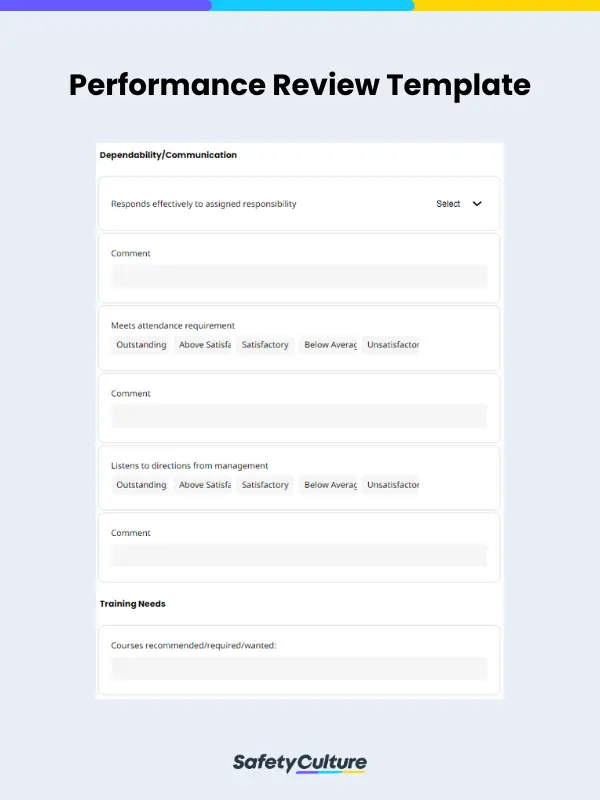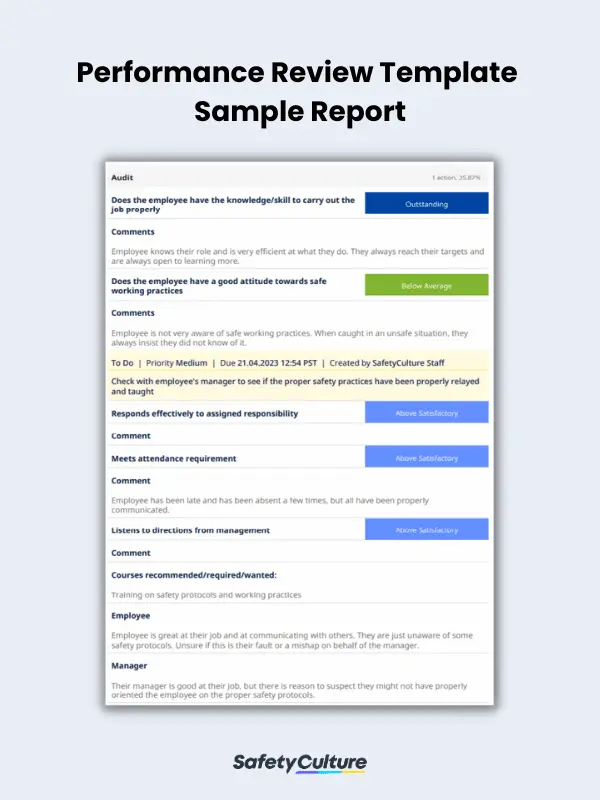What is a Performance Review Template?
A performance review template is a premade document that aims to help managers and employers objectively evaluate and analyze their employees’ performance, progress, and growth at work. Performance reviews are essential in determining the employee’s overall performance and identifying areas of strength and weaknesses that need improvement.
Importance
Performance reviews play a critical role in the overall development of an employee and the organization. They are an essential part of any organization’s HR process, as they assess an employee’s performance and provide feedback on areas that need improvement. By conducting regular performance reviews, you can improve and manage employee development, goal-setting practices, and accountability.
Performance reviews can also contribute to creating a culture of praise and recognition, ensuring that employees are properly rewarded for their achievements. In the process, this can improve overall company standing, as well as productivity and customer satisfaction.
However, conducting performance reviews can be a repetitive and tiring process, which is why creating and using a templated form for it can be beneficial in the long run. With a dedicated performance review template, you can cut back on the time spent managing documents for it and instead focus on connecting with your employees. It can also be a great help in ensuring proper processes are followed, as your managers and employees will be aware of the standards to follow and important key points to look out for.
Templated performance review forms can also help with the storage and management of files. With a digital performance review template specifically, you can access them anytime and anywhere without having to worry about lost, broken, misplaced, or mismanaged documents.
What to Include in a Performance Review Template
Although there are many ways to create and manage a performance review template, the most common ones have the following details:
- Knowledge of the employee on their current role and performance
- List of the employee’s goals, competencies, and accomplishments
- Notes on employee’s communication skills with others and upper management
- Notes on the employee’s attendance rate, tardiness, and absenteeism
- Observations on employee’s ability to listen to upper management and speak up when needed
- Points for improvement for the employee
To finish off the performance review template, it would be best to include a portion for your managers, the employee being evaluated, and the team director to sign off.
Here is a sample performance review template in use:
How to Use in Practice
A typical performance review process often follows this procedure:
1. Prepare for the interview
Preparation is the key to a successful performance review. Make sure to set aside the right time to conduct your performance review, as well as to review your employee’s status beforehand. This is also where you will ideally have your performance review template ready or in the process of being made.
2. Set expectations
Before and during the performance review, it helps to ensure that the employee understands what is expected of them and what they need to do to meet those expectations. This includes properly communicating with the employee and encouraging them to ask questions. The performance review template will be useful here in documenting observations and comments.
3. Listen actively
Active listening is a critical component of the performance review process. Not only does it help to ensure that the employee feels heard and understood, but it also helps their manager better understand them and avoid misunderstandings. This includes both verbal and non-verbal communication.
Using the performance review template can also help foster better active listening, as important findings and thoughts will be properly documented, making it easier to be referred to later.
4. Provide feedback
Providing constructive feedback is the most important aspect of the performance review process. It helps to ensure that the employee understands what they are doing well and what they need to improve on. Communicate the feedback to the employee, and make sure to also document it formally on your template.
Common Mistakes to Avoid
Conducting performance reviews is an important task that should not be taken lightly. It is an opportunity for employees to receive feedback on their performance, set goals for the future, and discuss any concerns or issues with their managers. However, there are common mistakes that can make the performance review process ineffective and counterproductive.
Here are some of the most common mistakes that can happen in a performance review:
1. Lack of preparation
All parties involved in a performance review should take the time to prepare for the meeting by reviewing the performance review template to be used, as well as the employee’s job description, performance objectives, and any previous feedback. Without adequate preparation, the review may become a vague and unfocused conversation, leading to confusion and frustration.
To avoid this mistake, managers should set aside enough time to review the employee’s performance and gather feedback from other team members. The employee should also prepare by reviewing their performance goals, accomplishments, and any challenges they faced during the review period.
2. Focusing only on negative feedback
Another mistake that can be made during a performance review is focusing only on negative feedback. While constructive criticism is essential for growth and improvement, focusing solely on the negative can be demotivating and disheartening for employees. It is important to acknowledge the employee’s strengths and successes as well.
This can be avoided by ensuring your managers provide balanced feedback that includes both positive and negative aspects of the employee’s performance.
3. Using vague language
Using vague language during a performance review can lead to confusion and misunderstandings. Managers improve and provide actionable steps to help them improve. Instead of using vague phrases, they should use specific examples of where the employee could improve and provide guidance on how to achieve this.
4. Not providing specific examples
One of the most significant mistakes that can be made during a performance review is not providing specific examples of where the employee excels or needs to improve. General feedback that lacks supporting cases can be difficult to understand and implement. This can be remedied by providing clear and realistic examples of the employee’s strengths and areas for improvement.
FAQs about Performance Review Templates
Ideally, a performance review should be conducted as often as possible. Some companies find that doing it quarterly or monthly will suffice, but others prefer to do it weekly.
Performance reviews and performance review templates are essential to employee performance management and appraisal as they give managers an idea of how to better help their employees reach their full potential. They also help managers identify points for improvement in their leadership and set goals for the company.
Although performance reviews are often associated with evaluating employees, there are also performance reviews conducted for managers. At its core, performance reviews are two-way conversations between managers and employees, meaning it is also normal for managers to be evaluated.




